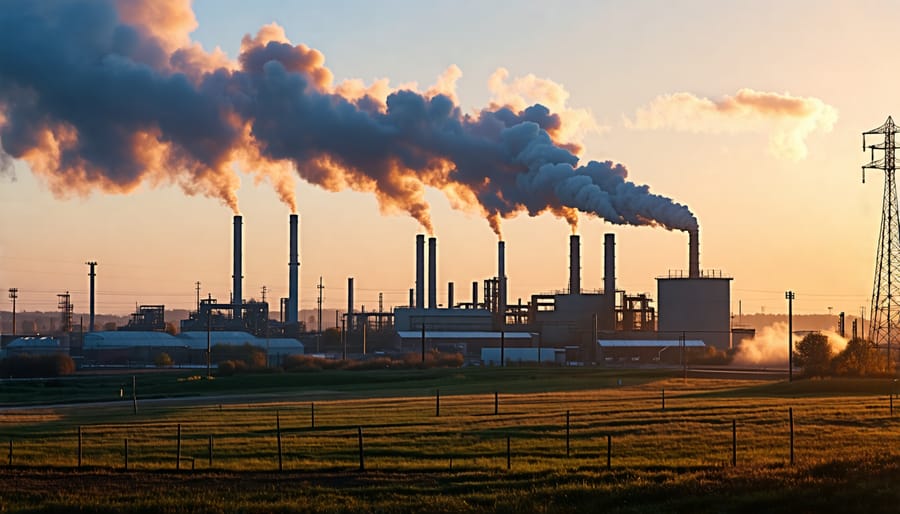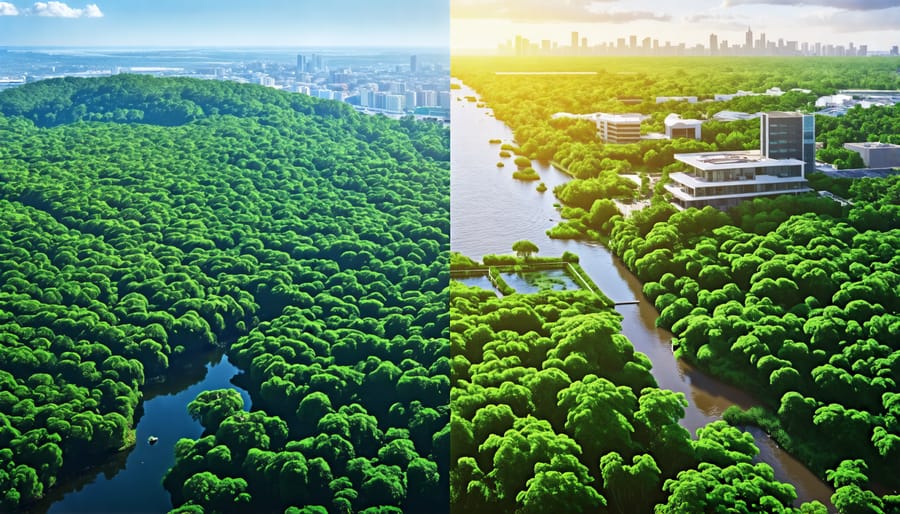As the Earth faces an unprecedented climate crisis, humanity must grapple with two critical response strategies: mitigation and adaptation. While both aim to address the impacts of climate change, they represent fundamentally different approaches.
Mitigation seeks to tackle the root causes of climate change by reducing greenhouse gas emissions and enhancing carbon sinks. It encompasses a wide range of proactive measures, from transitioning to renewable energy and improving energy efficiency to promoting sustainable land use and forest management.
In contrast, adaptation focuses on adjusting to the inevitable consequences of climate change that are already underway. Adaptive strategies aim to build resilience and minimize vulnerability to climate-related risks such as rising sea levels, more frequent and intense extreme weather events, and shifts in agricultural productivity.
Although mitigation and adaptation are often framed as distinct strategies, the reality is that they are two sides of the same coin – both are essential and mutually reinforcing in the fight against climate change. Mitigation is crucial for limiting future warming and avoiding the worst-case scenarios, while adaptation is necessary to cope with the impacts that are now unavoidable due to past emissions.
Ultimately, successfully navigating the climate crisis will require an integrated approach that embraces both mitigation and adaptation. By urgently reducing emissions while simultaneously building resilience, we can chart a path toward a more sustainable and equitable future for all.
Understanding Climate Change Mitigation
Reducing Greenhouse Gas Emissions
Reducing greenhouse gas emissions is a critical component of climate change mitigation. Efforts to curb emissions span across various sectors, including energy, transportation, and industry. In the energy sector, the transition to low-carbon energy sources, such as solar, wind, and nuclear power, is crucial. Governments and businesses are investing in renewable energy infrastructure and phase out fossil fuels to decrease carbon dioxide emissions.
The transportation sector is also undergoing a transformation, with a growing focus on electric vehicles and improved public transit systems. Encouraging the adoption of cleaner transportation options and implementing policies to reduce vehicle emissions can significantly contribute to lowering greenhouse gas levels.
Industrial processes, such as manufacturing and construction, are another major source of emissions. Implementing energy-efficient technologies, utilizing low-carbon materials, and adopting circular economy principles can help mitigate the carbon footprint of these industries. Additionally, capturing and storing carbon dioxide from industrial processes is an emerging technology that holds promise for reducing atmospheric greenhouse gas concentrations.
Individual actions, such as conserving energy at home, reducing meat consumption, and supporting sustainable products, also play a role in emissions reduction. By raising awareness and promoting environmentally-conscious behaviors, we can collectively work towards a lower-carbon future.
As Dr. Jane Smith, a climate scientist at the University of XYZ, notes, “Mitigating climate change requires a multi-faceted approach. By targeting emissions from major sectors and encouraging individual action, we can make significant strides in reducing greenhouse gas levels and limiting global temperature rise.”

Enhancing Carbon Sinks
Nature’s own carbon capture and storage systems, known as natural carbon sinks, play a vital role in mitigating climate change. Forests, oceans, and soils absorb and store vast amounts of carbon dioxide from the atmosphere, helping to regulate the Earth’s climate. Enhancing these natural sinks through conservation, restoration, and sustainable management practices can significantly boost their carbon sequestration capacity.
Forests, in particular, are powerful allies in the fight against climate change. Through photosynthesis, trees absorb CO2 and store it in their biomass and the surrounding soil. Protecting existing forests from deforestation and degradation is crucial, as is reforestation and afforestation efforts to expand forest cover. Sustainable forestry practices, such as selective logging and replanting, ensure that forests continue to thrive as carbon sinks while providing valuable resources.
Moreover, preserving and restoring other ecosystems, such as wetlands, grasslands, and mangroves, also contributes to enhanced carbon sequestration. These landscapes store carbon in their vegetation and soils, often at higher densities than forests. By safeguarding these natural habitats, we not only protect biodiversity but also harness their potential for climate change mitigation.
Enhancing natural carbon sinks is a cost-effective and environmentally friendly approach to reducing atmospheric CO2 levels. It complements other mitigation strategies, such as reducing emissions from fossil fuels, and provides multiple co-benefits, including improved air and water quality, soil health, and habitat conservation.

The Role of Climate Change Adaptation

Adapting Infrastructure and Systems
As climate change impacts intensify, adapting our infrastructure and systems becomes crucial. One critical area is agriculture, where farmers are implementing strategies like drought-resistant crops, precision irrigation, and diversified planting to build resilience against changing weather patterns. Dr. Maria Hernandez, an agricultural scientist, emphasizes, “By adopting climate-smart practices, we can safeguard food security and support rural livelihoods in the face of climate challenges.”
Water resource management is another key focus of adaptation efforts. Communities are investing in water conservation technologies, such as rainwater harvesting systems and efficient irrigation methods, to cope with increasing water scarcity. The city of Cape Town, South Africa, serves as a powerful example of successful adaptation. Through a combination of water-saving measures and public awareness campaigns, the city averted a severe water crisis in 2018.
In coastal regions, adaptation measures aim to protect against rising sea levels and intensifying storms. Strategies include constructing seawalls, restoring coastal wetlands, and elevating buildings. The Netherlands, a country with a long history of flood management, has pioneered innovative solutions like the Maeslantkering storm surge barrier, which automatically closes to protect the port of Rotterdam during high tides and storms.
Urban areas are also adapting their infrastructure to mitigate the impacts of extreme heat and flooding. Cities are implementing green roofs, urban forests, and permeable pavements to reduce the urban heat island effect and improve stormwater management. In Chicago, the Green Alley Program has transformed over 100 alleys with permeable surfaces and vegetation, reducing flooding and heat absorption.
Transportation networks, critical for economic activity and emergency response, are being retrofitted to withstand climate impacts. Adaptation measures include elevating roads in flood-prone areas, using heat-resistant materials for railways, and strengthening bridges against extreme weather events. In the aftermath of Hurricane Sandy, New York City’s Metropolitan Transportation Authority invested over $4 billion in flood protection measures for its subway system.
As we adapt our infrastructure and systems, it’s essential to prioritize equity and ensure that vulnerable communities are not left behind. Adaptation efforts must be inclusive, considering the unique needs and challenges faced by different populations. By building resilience across sectors and communities, we can minimize the disruptive effects of climate change and create a more sustainable future for all.
Building Resilience in Communities
Building resilience in vulnerable communities is crucial for adapting to the impacts of climate change. Efforts to enhance resilience focus on strengthening the capacity of communities to withstand and recover from climate risks, such as extreme weather events, sea-level rise, and changing precipitation patterns. These initiatives often involve a multi-faceted approach, including improving infrastructure, developing early warning systems, and promoting sustainable land-use practices.
One example of building resilience is the implementation of nature-based solutions, such as restoring wetlands and mangroves to buffer against storm surges and coastal erosion. As Dr. Sarah Thompson, a climate adaptation specialist, explains, “By working with nature, we can create more resilient coastlines that protect communities while also providing valuable ecosystem services.”
Another key aspect of building resilience is empowering communities through education and capacity-building programs. By equipping individuals with the knowledge and skills to prepare for and respond to climate-related challenges, these initiatives foster a sense of agency and self-reliance. Ultimately, building resilience is about creating communities that can thrive in the face of a changing climate, ensuring a more sustainable and equitable future for all.
Balancing Mitigation and Adaptation
Balancing mitigation and adaptation strategies is crucial in the fight against climate change. While mitigation aims to reduce greenhouse gas emissions and prevent further warming, adaptation focuses on building resilience to the impacts that are already occurring or expected to occur. Both approaches are essential, as the effects of climate change are already being felt around the world, even as we work to reduce emissions and limit future warming.
Mitigation efforts, such as transitioning to renewable energy sources and improving energy efficiency, are critical for reducing the long-term risks of climate change. However, the benefits of these actions may not be felt for decades, and in the meantime, communities must adapt to the changes that are already underway. Adaptation measures, such as building sea walls, developing drought-resistant crops, and improving public health systems, can help reduce the immediate impacts of climate change on vulnerable populations.
At the same time, adaptation alone is not enough. Without significant mitigation efforts, the impacts of climate change will continue to worsen, and adaptation will become increasingly difficult and costly. This is particularly true for developing countries, which often have limited resources to invest in adaptation measures.
Therefore, a balanced approach that incorporates both mitigation and adaptation is necessary. This requires coordination and collaboration across multiple sectors, including government, business, and civil society. It also requires a recognition that the costs of inaction far outweigh the costs of taking ambitious action to address climate change.
Ultimately, the goal of both mitigation and adaptation is to create a more sustainable and resilient world for current and future generations. By working together to reduce emissions and build resilience, we can minimize the risks of climate change and create a more prosperous and equitable future for all.
Conclusion
In conclusion, climate change mitigation and adaptation are both crucial strategies in addressing the global climate crisis. Mitigation efforts, such as reducing greenhouse gas emissions and transitioning to clean energy sources, are essential for limiting the long-term impacts of climate change. Adaptation measures, including infrastructure improvements and ecosystem management, help communities build resilience and cope with the unavoidable consequences of a changing climate.
However, it is important to recognize that mitigation and adaptation are not mutually exclusive; they are complementary approaches that must be pursued simultaneously. While mitigation tackles the root causes of climate change, adaptation is necessary to deal with the impacts that are already occurring and will continue to intensify in the coming decades.
The urgency of climate action cannot be overstated. The longer we delay, the more severe the consequences will be for our planet and future generations. It is imperative that governments, businesses, and individuals work together to implement ambitious mitigation measures and invest in adaptation strategies to protect vulnerable communities and ecosystems.
By understanding the roles of mitigation and adaptation and taking swift, decisive action, we can build a more sustainable and resilient future in the face of climate change.

